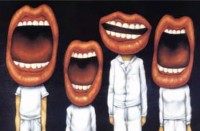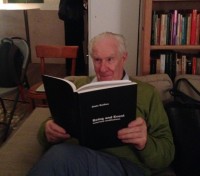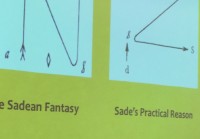Manifesto Fest in DIVISION/Review
A group, including many Unbehagen members, presented a Manifesto Fest at the 2015 Division 39 Spring meeting in San Francisco. Click here to read the manifestos of Will Braun, Jill Gentile, Lynne Layton, Tiffany McLain, Tracy Morgan, Jonathan Shedler, Esther Sperber & Robert Stolorow, published in DIVISION/Review (posted with permission from DIVISION/Review).
Jamieson Webster: Speaking into the Void of the Unbehagen SalOon Listserv
DU tends to forget itself, which isn’t a bad thing. And the idea of DU, and its various allegiances, shift and grow and mutate which is a small miracle in often stuck communities. There are a lot of new people on the list serve, people who haven’t attended events, people who only know one another virtually, which is also a new situation. It is something of this new culture which I think creates tension on the list serve and a growing rhetoric of splitting- academic v clinical psychoanalysis, affects v language, interpretation v relationship, intellect v feeling, Lacan v everyone else. That’s fine. It’s an important stage. Personally, I think these are false divisions- in particular the academic v clinical psychoanalysis one, which I think tends to break things down ...Read More
Evan Malater & Cecilia Wu: Rumplefreudskin – The Fantasy of the Immortal Plaque
In a famous letter to his interlocutor Wilhelm Fliess, Freud imagined that the place where he had and decoded the Irma injection dream would be one day marked by a plaque. ” Do you suppose that one day a marble tablet will be placed on the house, inscribed with these words: ‘On July 24, 1895 the secret of dreams was revealed to Dr. Sigmd Freud.’ A few days ago, I was talking to Cecilia Wu of the plaque fantasy as an example of the brash confidence of the early Freud, only to have her tell me that the tone of the letter is hardly triumphant or brash. “What do you mean?,” I said. Cecilia pointed out that he goes on to write, “At this moment I see little prospect of it.” That is to say, he saw little prospect that his plaque fantasy would ever be anything bu...Read More
A Panel for the Launch of George Makari’s “Soul Machine: The Invention of the Modern Mind”
“Imagine a time in the future when your mind might travel. Perhaps it would enter a different torso or a foreign face. Would you still possess the same self, the same being? Our minds, most of us would agree, define us; they carry our personhood, and where they go, we go too. In Western culture, much depends upon this belief; it underpins a great deal of our literature, art, politics, and jurisprudence. It is the foundation of the commonsense psychology so crucial to social life. The concept of the mind is everywhere, and yet at the same time, it is strangely nowhere. The most powerful arbiter of truth in contemporary life, natural science, refuses to ratify this belief. While our own psyches seem abundantly clear to us, attempts to objectively establish their existence have been mir...Read More
a/cephalic discontents: an event series curated by das unbehagen
“A dictionary begins when it no longer gives the meaning of words, but their tasks. Thus formless is not only an adjective having a given meaning, but a term that serves to bring things down in the world, generally requiring that each thing have its form. What it designates has no rights in any sense and gets itself squashed everywhere, like a spider or an earthworm. In fact, for academic men to be happy, the universe would have to take shape. All of philosophy has no other goal: it is a matter of giving a frock coat to what is, a mathematical frock coat. On the other hand, affirming that the universe resembles nothing and is only formless amounts to saying that the universe is something like a spider or spit.” – Georges Bataille, Formless Click here to view the details f...Read More
Double Entendre: Katy Bohinc, Rachael Wilson & Jamieson Webster respond to Alain Badiou
Wendy’s Subway presented performances and discussion of Bohinc’s “psycho-sexual thriller” Dear Alain, Webster’s The Life and Death of Psychoanalysis (Karnac Books, 2011), which addresses Badiou’s theory of love and asks how it may be conceived from the psychoanalyst’s discourse; and Wilson’s “Fifteen Theses,” on her artist’s book created from Badiou’s Being and Event to investigate the rhythms of reading, pleasure in distraction, and the book as a “cover.” Badiou attended performatively, as an audience member. Click here to listen to Jamieson Webster at Wendy’s Subway Click here to listen to Rachel Wilson and Katy Bohinc at Wendy’s Subway Post-show discussion: Cecilia Wu responds to Jamieson Webster’s “Alain Badiou is Not a Walk in the Park”: Jami...Read More
Dana Amir: Cleft Tongue: The Language of Psychic Structures
“The scene of perversion is a scene of seduction. In this scene, which is shared, whether consciously or not, by two people, there is a continuous continuous reversal of roles in which the chosen object, the person on which the perverse subject actually depends and with whom he yearns to fuse, turns from being the one in power into the one who is led, unbeknownst to him and sometimes against his own will, into the perverse labyrinth. Whence does the perverse seduction take its power? How does the perverse subject go about the seduction scene? What allows him or her to recognise precisely the other’s needs, and what enables him or her to so smoothly penetrate that other? The perverse subject’s accurate identification of the other’s needs is not a true identification ...Read More
Muriel Dimen: A Last-Minute Breakthrough – New York Times Couch
“Julia returned after the August vacation that we New York psychoanalysts customarily take. Well, not right after. She missed the first session. A family obligation, she said. Were I a traditional analyst, I might have wondered to myself: “Is there ambivalence here? Perhaps she doesn’t want to come back?” But I didn’t think that, or rather I ignored that flicker of doubt. I should have trusted my suspicions. When she did show up, Julia told me that she wanted to end the therapy. Very forthrightly, too. Cordially. She asked me about my summer and then said that this session would be her last.” Click here to read more
Jamieson Webster & Nuar Alsadir in conversation with Barry Yourgrau for the launch of “Mess”
“The word “hoard” derives from the proto-Germanic term for “hidden or secret treasure.” Hoards are well known to archeologists, dating back over 10,000 years to the hunter-gatherers of the Stone Age. Foodstuffs such as joints of meat were common early deposits, ditto ornaments, weapons, and human remains— all buried for safekeeping and intended for retrieval. The hoards of the later Bronze and Iron Ages got more elaborate: sumptuous weapons (lots of axes), tools, jewelry, coins. Votive hoards, or ritual offerings, though, were interred permanently. Often in watery areas, and after being rendered useless, I noticed: many broken swords flung into rivers. I couldn’t help think of myself destroying my old bowl before sending it down the garbage chute. But here was the thing: those caches of ba...Read More
Dany Nobus: Writing as an Instrument of Torture – An Exploration of Sade’s Practical Reason via Lacan’s “Kant with Sade”
Of the twenty-eight substantial papers and six shorter contributions that make up Lacan’s Écrits, “Kant with Sade” is generally regarded as one of the toughest nuts to crack, and this opinion is shared by some of the most eminent and knowledgeable commentators on Lacan’s work. In this seminar, I will unpack one of the crucial lines of Lacan’s argument in “Kant with Sade”, notably that the contents of Sade’s libertine novels, which he also designated as “the Sadean fantasy”, i.e. the fantasy Sade articulated as a literary text within the space of his creative imagination, cannot be mapped directly onto the author’s life. Although it is the ‘sadistic’ fantasy of Sade’s libertine heroes that tends to dominate within the Sadean fantasy—whose full spectrum also includes the more ‘masochistic’ s...Read More
Josh Cohen: Art, Psychoanalysis, Art and the Logic of Indifference
“As Leo Bersani and others have observed, there is a paradox at the heart of the Freudian corpus that animates and finally undoes it. In resisting the theoretical innovation of the death drive, Freud’s contemporaries were resisting an inner tendency of psychoanalysis to corrode the capacity of any stable concept to contain and master the forces it discloses. It’s with a certain poignancy of understatement that Freud describes the existence of masochism, in his 1925 essay on the subject, as a ‘problem’ from an economic point of view. ‘Eco – nomos’, the law of the home, the even flow and distribution of energy, is ruined at a stroke by masochism, the psycho-sexual preference for pain over pleasure, for the heightened agitation rather than contented homeostasis of the organism. But as J...Read More
Orna Shachar: The Therapeutic Gaze – New York Times Couch
“Daniel, a handsome 50-year-old whom I name the Marlboro Man because of his hyper-masculine looks and swagger, walks into my office and drops his body on the couch across from me. In a monotonous voice, his speech laced with obscenities, he announces his failure — his failure in life, in relationships with women, at work. He sits with his legs wide apart, as if penetrable, open and passive. Yet this posture also somehow feels invasive, penetrating and even threatening to me.” Click here to read more























